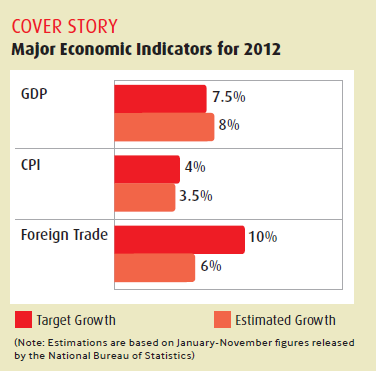|

Steady advancement
The CEWC stressed the need to "actively and steadily" press ahead.
Zhang said that the Chinese economy is experiencing two significant changes: a move from high-speed growth to stable growth; and from an expansion of scale to development based on quality and efficiency, adding that the government is taking an "active and steady" approach to ensure the changes continue.
"Steady" refers to stabilizing economic growth and price levels, while "active" refers to pushing forward economic restructuring and the pursuit of high quality economic growth, said Zhang.
Since the fourth quarter of 2010, economic growth was in steady decline for seven consecutive quarters. Although growth appears to be rebounding, Zhang said, the foundation for stronger growth remains weak.
"The biggest problem with the Chinese economy is not its growth rate but its quality and efficiency. If these problems cannot be fundamentally solved, the Chinese economy will be unstable," said Yao Jingyuan, a researcher with the Counselors' Office of the State Council, in an interview with Xinhua News Agency.
To ensure stable economic growth, the CEWC decided to maintain a proactive fiscal policy and prudent monetary policy in 2013 to make counter-cyclical regulation and advance economic restructuring.
Liu Shangxi, Deputy Director of the Fiscal Science Research Center at the Ministry of Finance, said that although uncertainties in the global economy could hinder China's growth, any impact wouldn't be so great as in 2008-09. Therefore, in terms of fiscal policy, there is no need for China to formulate such expansionary measures.
Yuan Gangming, a researcher with the Institute of Economics at the CASS, predicted that in 2013 China will expand its financing scale and maintain its credit growth.
Since 2011, the Chinese Government lowered the rate at which it issues its currency from 16 percent in 2010 to 14 percent in order to control inflation. In 2012, China's growth of consumer price index (CPI) was much lower than in the previous year, reaching 1.9 percent in October, the lowest in the past decade. Yuan said that as long as inflation remains under control, the government may raise its rate of currency issuance back to 16 percent in 2013.
Since the United States, the European Union and Japan are witnessing slow growth, China's foreign trade has been encumbered. When fixed assets investments start to grow rapidly, the Chinese Government has pushed domestic demand as the major stimulus for economic growth.This conference also emphasized urbanization as a means to stimulate consumption growth. The country will actively and steadily advance urbanization while ensuring that a population shift from rural to urban is done in an orderly fashion.
Major Tasks for 2013
1. Enhance and improve macro-control and promote sustainable and sound economic development;
2. Consolidate the foundation for agriculture and ensure supplies of farm produce;
3. Accelerate the adjustment of industrial structure and improve overall industrial quality;
4. Press urbanization forward and focus on improving the quality of urbanization;
5. Strengthen the social security system and improve people's livelihood; and
6. Comprehensively deepen economic reforms and expand opening up.
(Source: Statement of the Central Economic Work Conference) |